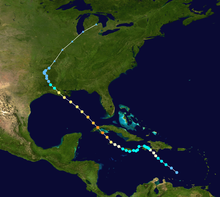 Track of Hurricane Gustav | |
| Meteorological history | |
|---|---|
| Formed | August 25, 2008 |
| Extratropical | September 4 |
| Dissipated | September 7, 2008 |
| Category 4 major hurricane | |
| 1-minute sustained (SSHWS/NWS) | |
| Highest winds | 155 mph (250 km/h) |
| Lowest pressure | 941 mbar (hPa); 27.79 inHg |
| Overall effects | |
| Areas affected | Haiti, Dominican Republic, Jamaica, Cayman Islands, Cuba, United States |
Part of the 2008 Atlantic hurricane season | |
The meteorological history of Hurricane Gustav spanned eleven days, from August 25 to September 4, 2008. The tropical disturbance which eventually spawned Hurricane Gustav gathered on August 16, southwest of the Cape Verde islands, but was slow to develop as it trekked west across the Atlantic. Upon reaching the warm waters of Caribbean Sea it began to organize and became a tropical depression on August 25. It quickly strengthened to a tropical storm, and then a hurricane, before making landfall on Haiti's southwest peninsula. Gustav was severely disrupted by Hispaniola's mountains and stalled, disorganized, in the Gulf of Gonâve between August 26 and 27.
Deep convection reformed the storm's center southwest of Haiti, near Jamaica's east coast. Under the influence of a mid-level ridge that extended from the Gulf of Mexico to the western Atlantic Ocean, Gustav picked up a westward motion. It was briefly disrupted by Jamaica as it passed over the mountainous island but rapidly strengthened when it moved over open water once again. Reaching Category 4 strength about 24 hours after having been upgraded to a hurricane, Gustav brushed the Isle of Youth and made landfall on Cuba's western's peninsula.
Disrupted by mountains once again, Gustav never regained its former strength. Briefly traveling over a warm eddy of the Gulf Stream's loop current it encountered moderate wind shear and cooling sea surface temperatures. Fluctuations in its internal structure and visible appearance did not counter the storm's general weakening trend, and Hurricane Gustav made its final landfall as a Category 2 hurricane near Cocodrie, Louisiana on September 1. Moving inland, the storm quickly weakened but persisted as a significant tropical depression until it was adsorbed by a frontal boundary on September 5.